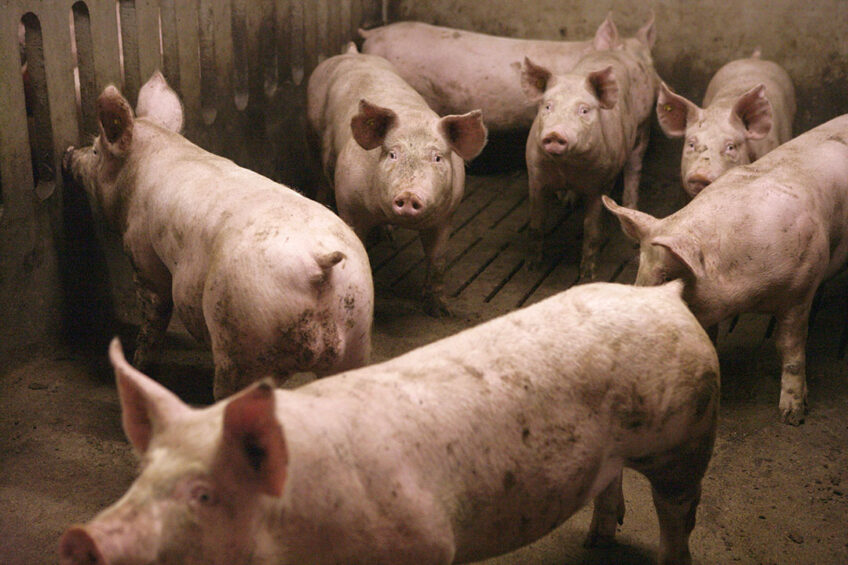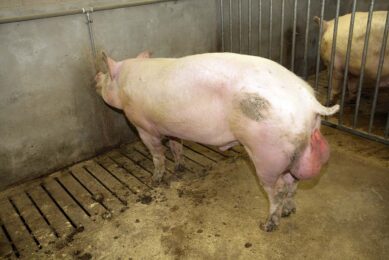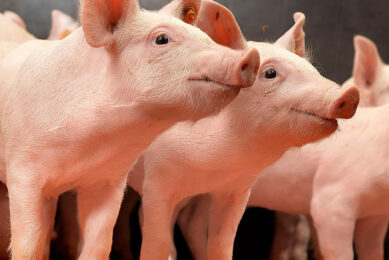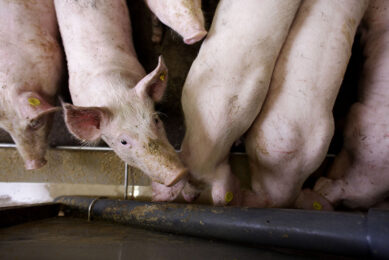Pork from entires, without the taint, please

When raising entire pigs, it is critical to avoid the occurrence of pork that carries boar taint. There are various ways this can be controlled, for example by taking the genetics route, by concentrating on the right nutrition and also by creating systems that pick out tainted carcasses at the slaughterline.
The production and valorisation of meat from entire male pigs was the topic of a presentation by Patrick Chevillon on 5 October at the most recent edition of the Sommet de l’Elevage, in Clermont-Ferrand, France. Chevillon is head of meat quality and slaughterhouses at the French Pork and Pig Institute (IFIP). This article is a summary of his presentation.
According to IFIP, of a total of 255 million pigs slaughtered in Europe per year, 45 million are entire males. Of the slaughtered pigs, 50% are females, 30% castrated pigs, 18% entire males and 2% Improvac vaccinated. Table 1 further details the distribution of the entire males’ share by country. Spain leads with 22 million entire males slaughtered per year, followed by smaller figures for other EU countries. In France, the overall trend for entire males has been showing a slight yet constant increase since 2017. This applies to 14% of slaughtered carcasses, that is, 28% of males produced in France.
Minimising boar taint through management
When the pigs are still on the farms, various strategies can help minimise the risk of occurrence of boar taint:
- The use of lean genetics, which are not very sexually mature;
- An adapted ad libitum diet in energy;
- Protein;
- Feed enriched in fibre, with possibly some suitable raw materials in feed at the end of finishing;
- Clean pigs; and
- Precautions during transport and slaughter, for instance by limiting stress, fights, unhygienic conditions or endless waiting.
Androstenone and skatole are key markers of boar taint. Androstenone is produced by the testicles and is stored in the salivary glands and fat. It increases at puberty and its presence is a few days in living animals. Skatole, on the other hand, is produced by the intestinal bacterial flora from tryptophan. Deposited in fatty tissue, it is degraded in the liver and is present for a relatively short time in a boar’s body (ten to 12 hours). The odour of skatole is more marked in summer in dirty animals, and it may also be present in females.
Minimising boar taint through genetics
Genetics is the key factor to reducing boar taint. On average, skatole is 3 times more likely to be found in Hampshire than in the Yorkshire breed; similarly, it is three times more likely that androstenone will be found in Duroc than in the Piétrain breed.
There are a lot of genetics initiatives being used, not only in Europe, to reduce odour risks (see Box).
Many questions, however, persist in genetics and boar taint risk in entire males: What impact does the choice of sow have? What is the impact of lines currently used in Duroc (9% of doses sold in artificial insemination centres in 2020)? How can fatter pigs be selected without boar taint risk?
Minimising boar taint through nutrition
The increase in ileal digestibility of the feed has no influence on the content of androstenone from fat. On the other hand, there is undoubtedly an unfavourable effect on skatole with a lack of fibre. Trials by the Danish Pig Research Centre SEGES have shown a reduction of boar taint with some fibres:
- A reduction of 60% with 15% chicory across 4 days;
- A reduction of 56% with 10% beet pulp across 14 days;
- A reduction of 44% with 10% Jerusalem artichokes across 14 days; and
- A reduction of 33% with 10% palm cake across 14 days compared to control.
Some specific additives have been developed by some feed companies to reduce boar taint issues, offering an alternative to castration. Among them, Taintstop was developed by the Belgian feed company Dumoulin. Field tests carried out with Taintstop show a decrease in skatole content of 2.5 to five times.
Carcass differences
In his presentation, Chevillon also pointed out differences between entire males and castrated animals regarding carcass composition. A Danish trial with Danish genetics (Duroc boars) concluded that there is a different distribution in the weight of the cuts, for instance +0.41 kg for front pieces (chine, shoulder), -0.25 kg for middle cuts and -0.16 kg for hams for entire males compared to castrates. Furthermore, there is a difference in tissue composition for each cut between castrates and entire males (see Table 2). Those composition differences lead to two questions: Should the salting and curing industries adapt their recipes to entire males? Should pork producers come up with fatter entire males?
Detecting boar taint at the slaughterhouse
2 methods are currently used to detect boar taint at slaughterhouses. The more commonly used method is the human nose (e.g. in France, the Netherlands, Germany, Belgium, Spain).
A second method is currently being tested, involving a real-time laboratory chemical analysis test for skatole and androstenone. This method is being applied at Danish Crown in Denmark, at a speed of 700 pigs per hour. The ultra-fast laboratory method allows the quantification of markers of odorous molecules, but it does require sample preparation. Research is underway to develop indirect methods without sample preparation.
The question remains: What should be done with the odorous carcasses detected by the human nose? In October 2020, the Danes published a “Catalogue of application of meat from entire male pigs with boar taint” containing several solutions:
- Temperature;
- Smoking;
- Fermentation;
- Dilution;
- Masking;
- Complexity (association); and
- Curing.
Chevillon quoted other concrete solutions, such as sorting the females for certain markets to be secured (fresh, sausages, butchers) and sending the tainted entire males to a non-risky market after testing.
Genetic initiatives to reduce pig odours
• Axiom: Valent boar;
• BHZP: Genomic selection, muscular Piétrains;
• DanBred: Genomic selection, muscular Duroc;
• Inodorous: Low odour Piétrain, developed in partnership with German Piétrain Denmark. This is a very strong growing, low IC, odourless NN Piétrain boar, well suited to the entire male market;
• Hypor: genomic selection;
• Nucléus: INO boar, classic selection on blood test (oestradiol + testosterone content);
• PIC/Genus: genomic selection (boar taint);
• Suisag: Classical selection, station and artificial insemination centres (fat biopsy, selection on androstenone values); and
• Topigs Norsvin: Selection by human nose since 2009; use of markers; genomic selection (Nador boar).
Source: Patrick Chevillon, IFIP.











